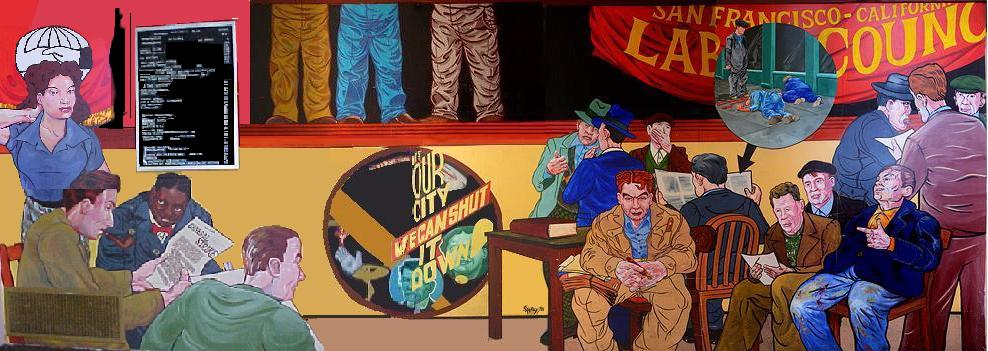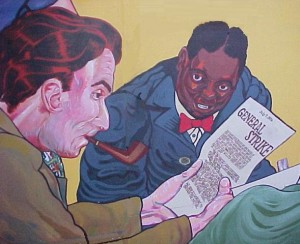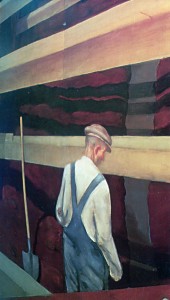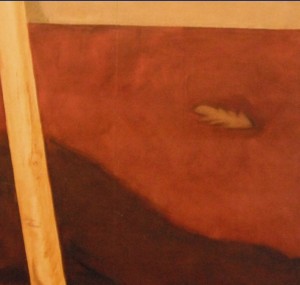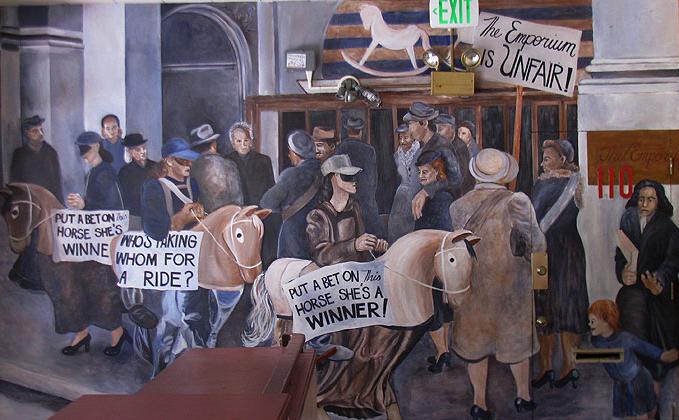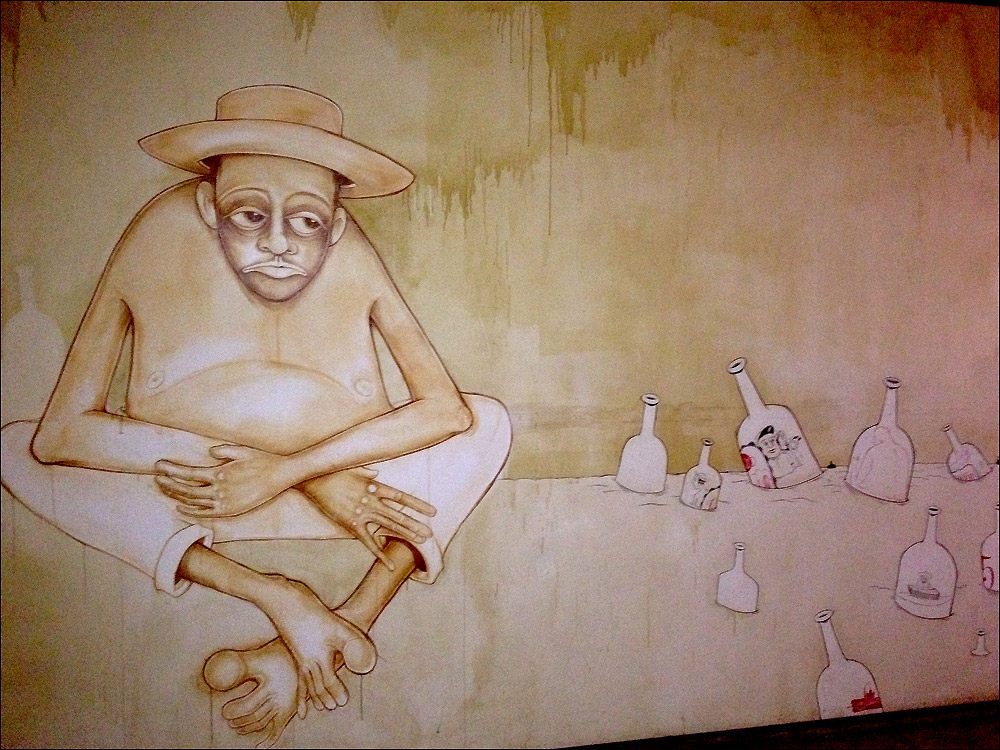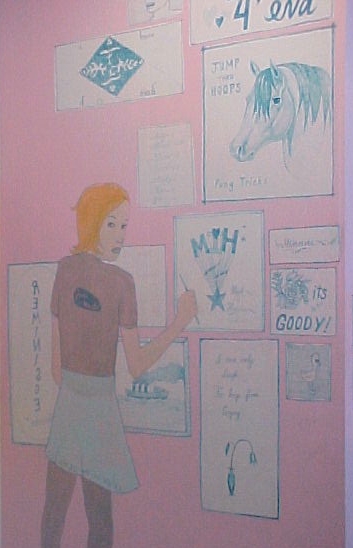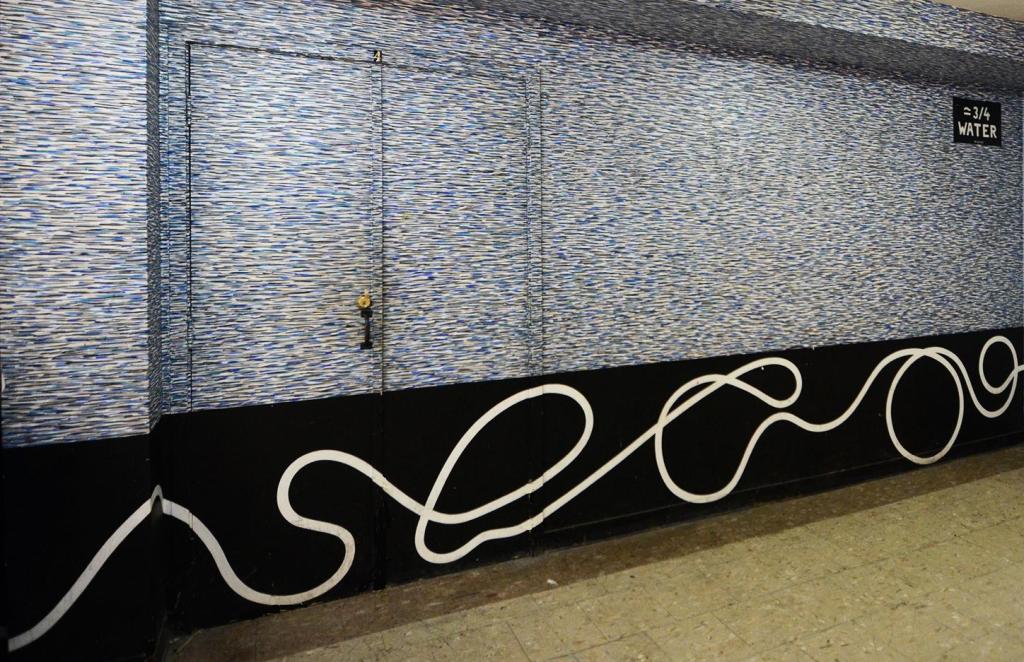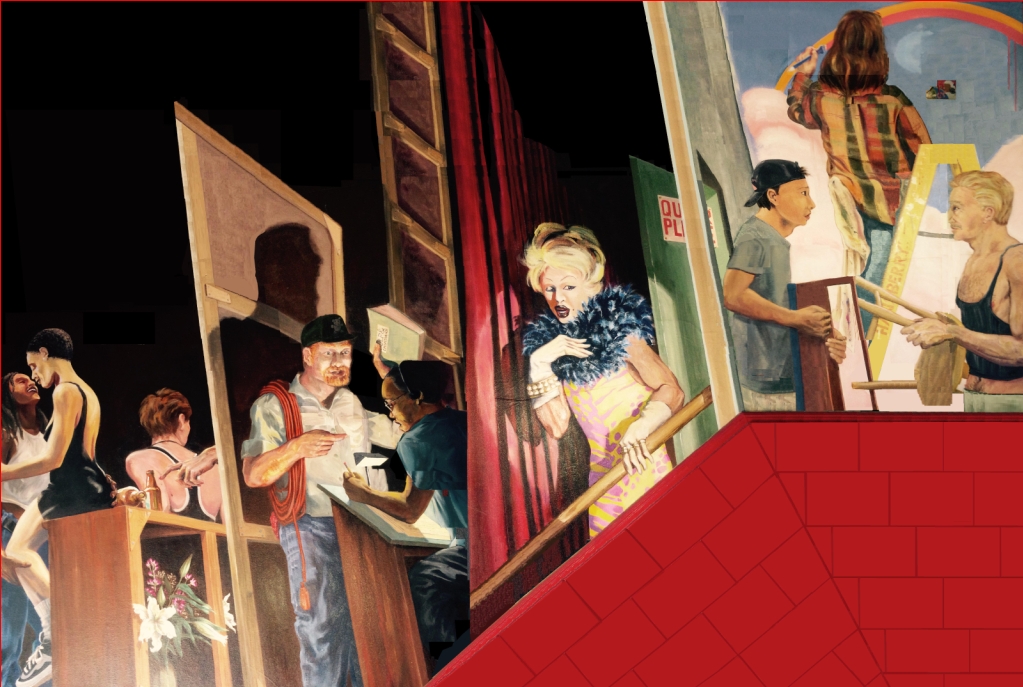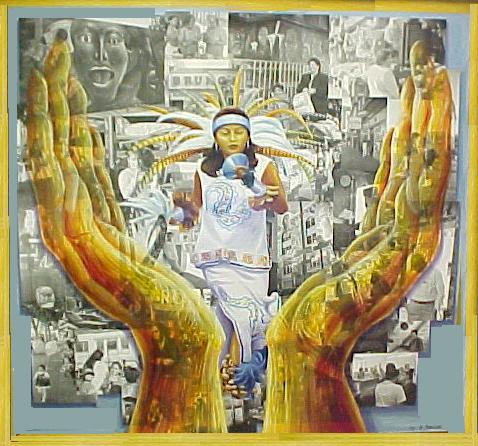Redstone Murals
Mural Background
The Clarion Alley Mural Project (CAMP) proposed a series of murals at the Redstone Building in 1996 with the goal of depicting the building’s tenant history. The building was built by the San Francisco Labor Counsel between 1910-14 to be the home for the city’s labor movement. From its opening until 1969, it was known as the San Francisco Labor Temple. It was then known as the Redstone building that, being the home for various non-profit groups serving the Mission District. Most of the murals depict the historic labor history.
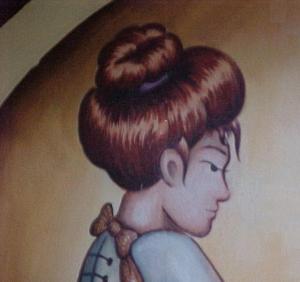 The $40,000 Redstone Building Mural project money came from a failed $1.3 million grant originally given to the Mission Armory Foundation back in 1989 for the purpose of turning the long abandoned SF Armory on 14th and Mission into a Latino Community Center.
The $40,000 Redstone Building Mural project money came from a failed $1.3 million grant originally given to the Mission Armory Foundation back in 1989 for the purpose of turning the long abandoned SF Armory on 14th and Mission into a Latino Community Center.
The $1.3 million grant was insufficient to cover the renovation costs of the former state militia site. So the coalition of Latino organizations led by Mission Legal Defense (a former Redstone building tenant) spent years looking for another building to purchase, including the Redstone building as an alternative candidate, but failed to come to agreement. Brown would take the money and give it to the arts community. Sadly, the Redstone building wasn’t selected for purchase, but did get our murals.
The Lab’s proposal, in conjunction with artists from the Clarion Alley Mural Project (CAMP) was accepted in 1996. After months of research and interaction with Redstone tenants, eleven murals depicting the building’s history were completed including five that highlight the labor movement. The murals were dedicated on January 18th 1997 at a public ceremony that included Mayor Willie Brown.
The artists: Aaron Noble (project Coordinator), Rigo 97, Susan Greene, Sebastiana Pastor, Isis Rodriguez, Chuck Sperry, Barry McGee, Carolyn Castaño, Ruby Neri, John Fadeff, Scott Williams, and Matt Day; Many of these artists have had to leave the area due to the ongoing gentrification of the Mission. See Megan Wilson’s (a former Redstone tenant) detailed history on the displacement of SF Artists.
[/wptabcontent]
[wptabtitle] Labor[/wptabtitle] [wptabcontent]
The most prominent of the murals in the main lobby was done by Chuck Sperry that is based on images from the 1934 General Strike that followed the death of two workers on July 5th, following weeks of confrontations between waterfront workers and the port’s employees. Chuck’s drawing is a composite of a number of photographs during the 1934 strike. The first image is of Howard Sperry and Nicolas Bordoise laying dead, with the other being Harry Bridges in a circle of men looking at one of the strike documents. The man with bright red hair is Vincent Hallinan, the lawyer that defended Harry from deportation over the next twenty years. In the upper left is Jennie Matyas a organizer with the International Ladies Garment Workers Union who played a prominent role in organized Asian women workers in the city.
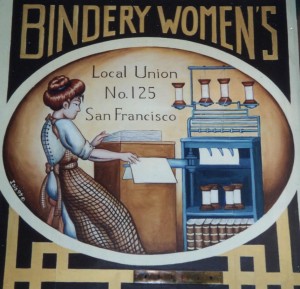 Over the elevator and Immediately to the right is a mural depicting of the Women’s Local 125 Bindery Union. This mural was done by Isis Rodriguez depicting their union that was an early tenant at the SF Labor Temple between 1915-17. Isis is a Latina from the mid-west that became part of movement known as “The Mission school” that included the Clarion Alley Mural project in the mid 1990’s. The women’s local was started in 1902 but reluctantly agreed to merge with the men’s local bindery union in 1917. The Labor Archives Research Center at San Francisco State has an extensive set of materials about the Women’s union and has done special events around the local in the past.
Over the elevator and Immediately to the right is a mural depicting of the Women’s Local 125 Bindery Union. This mural was done by Isis Rodriguez depicting their union that was an early tenant at the SF Labor Temple between 1915-17. Isis is a Latina from the mid-west that became part of movement known as “The Mission school” that included the Clarion Alley Mural project in the mid 1990’s. The women’s local was started in 1902 but reluctantly agreed to merge with the men’s local bindery union in 1917. The Labor Archives Research Center at San Francisco State has an extensive set of materials about the Women’s union and has done special events around the local in the past.
Directly opposite of Sperry’s mural in the lobby, along the south wall of the building is John Fadeff’s work. His earth tone mural includes a measuring stick across the top, a large shovel to the left of the door, and on the right, a union man alongside a shovel working on the Labor Temple back in 1914. The large shovel to the left of the door includes a small artifact about eight feet off the floor that was an Ohlone artifact found while excavating the site.
To the left of the door, and up the stairs that lead to the first floor is Susan Greene‘s depiction of the 1941 department worker’s union strike at the Emporium on Market and 5th. Strikers wore all kinds of nifty costumes depicting robots, to the women riding hobby horses during the two month long strike. Susan is a tenant at the building as well as on the faculty at the San Francisco Art Institute.
Sebastiana Pastor’s mural documents the important 1938 Dollar Store 15 week strike organized by Jenny Matyas and the International Ladies’ Garment Workers’ Union (ILGWU) local 361. This was the first time unions were able organize Chinese workers in San Francisco’s Chinatown. Jenny can be seen in the very upper left corner of Chuck Sperry’s 1934 General Strike mural as well.
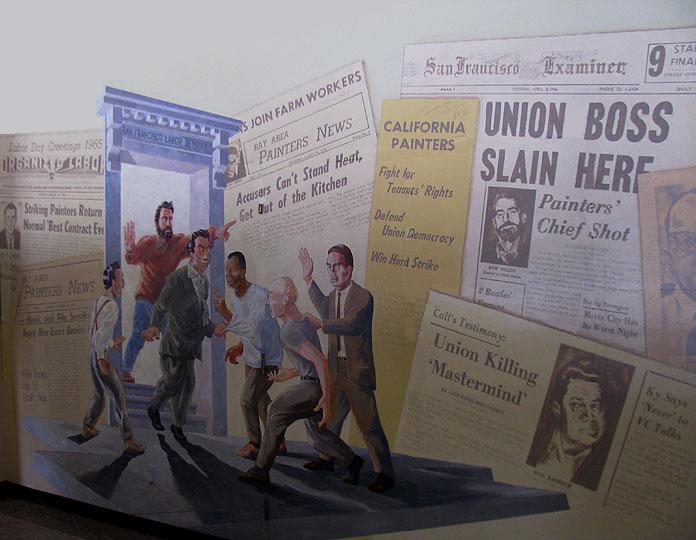 The last labor related mural is Aaron Noble‘s depiction of the assassination of Dow Wilson on the first floor reminds us of a tragic moment in 1966 when the the young labor leader for local 4 of the painters union lost his life.
The last labor related mural is Aaron Noble‘s depiction of the assassination of Dow Wilson on the first floor reminds us of a tragic moment in 1966 when the the young labor leader for local 4 of the painters union lost his life.
Dow Wilson (1926-1966) was a militant democratic union leader that played an important role in integrating painters in the bay area. He was elected Secretary Treasurer of the Painter Union Local 4, leading a campaign to hire black workers n the Golden Gate Bridge. He also fought the contractors and for democracy in his local. He was assassinated by corrupt East Bay Union leader and painting contractors across the street from the Labor Temple. See Herman Benson’s history on corruption that includes an extended review of what happened to Dow Wilson.
Local 4 would eventually be dismantled under suspicious circumstances. Their local and Dow have been memorialized by SF Worker’s United.
[/wptabcontent]
[wptabtitle] Other[/wptabtitle] [wptabcontent]
Barry McGee’s piece is supposed to depict the drunken visions of a Latino’s immigration experience. This particular image was more than slightly controversial as the only image representing the building’s prominent latino history, including many groups like Catholic Charities, the credit union and Mission Legal Services.
Ruby Neri’s mural was done at the time when the North Mission had an extensive women’s community that included the Luna Sea theater on the 2nd floor. This image was meant to explore the changes young women were going through.
Rigo 97 would do the above water mural to represent environmental groups that were in the building. One of these groups was the Abalone Alliance which actively opposed the opening of the Diablo Canyon nuclear station. Nuclear reactors are one of the largest users of water in the world, with the two above reactors using 2 billion gallons of water a day.
During the 1980’s San Francisco’s Filipino Community Center took control of the old auditorium on the first floor, using the space for senior ballroom dances. This Mural was done by Carolyn Costano. More often than not, you could find Brad the building’s manager flirting and dancing with the ladies.
This mural was the last of the murals added to the first floor and was done by Aaron Nobel. Aaron was coordinator for the murals project at the building and is the 2nd of his two murals he did. Its located on the 2926 stairway that exits the building on the east side of the building. The mural depicts front and backstage activities during a rehearsal. The Theatre Rhinoceros was a tenant at the building for over 30 years but was forced to leave the building in 2010 due to major rent increases. They were the first gay theater in the US. It should be noted that the theater used Union actors at all of its events.
Other Murals
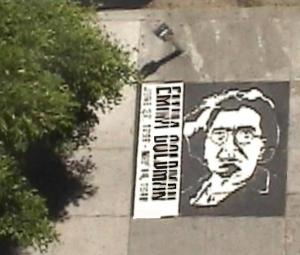 Over the years, there have been other murals in and outside of the building. For example, an activist painted a silhouette image of Emma Goldman in 2005 on the sidewalk immediately to the left of the main entrance. The image slowly faded away, with the last of it being removed by new concrete around 2012.
Over the years, there have been other murals in and outside of the building. For example, an activist painted a silhouette image of Emma Goldman in 2005 on the sidewalk immediately to the left of the main entrance. The image slowly faded away, with the last of it being removed by new concrete around 2012.
Another very gorgeous mural was done by the Mission Area Federal Credit Union (MAFCU) in the lobby (suite 305) a few years after the murals on the first floor were done. It consisted of an indigenous woman in the center, held up by glowing hands and surrounded by a collage of local community issues/drawings. MAFCU moved to larger accommodations in 2008, taking the mural with them. They were taken over by a larger chain of Credit Unions from the Southeast a few years later.
Luna Sea was a popular women’s theater project that lasted from 1994 through 2004 that was located on the 2nd floor of the Redstone Buildling. Below is one incarnation of a murals located in the entry to their space.
The 2nd floor contains another mural produced by the homeless activists community. Its located in suite 200 just outside the door of the Western Regional Advocacy Project or WRAP.
[/wptabs]
